高中英语阅读教学设计案例
高中英语小说类文章阅读理解教案
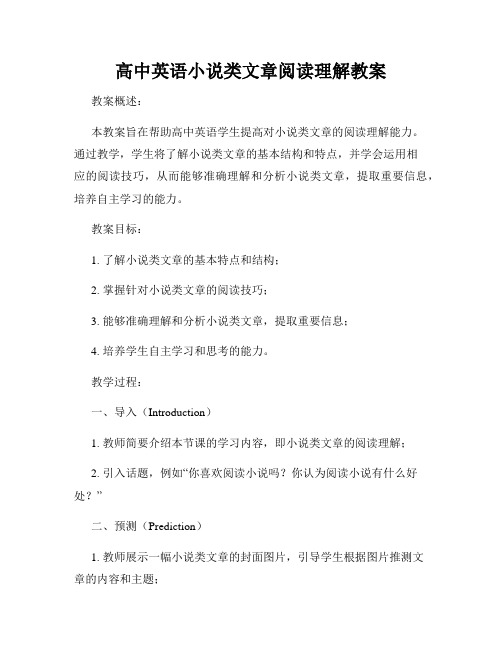
高中英语小说类文章阅读理解教案教案概述:本教案旨在帮助高中英语学生提高对小说类文章的阅读理解能力。
通过教学,学生将了解小说类文章的基本结构和特点,并学会运用相应的阅读技巧,从而能够准确理解和分析小说类文章,提取重要信息,培养自主学习的能力。
教案目标:1. 了解小说类文章的基本特点和结构;2. 掌握针对小说类文章的阅读技巧;3. 能够准确理解和分析小说类文章,提取重要信息;4. 培养学生自主学习和思考的能力。
教学过程:一、导入(Introduction)1. 教师简要介绍本节课的学习内容,即小说类文章的阅读理解;2. 引入话题,例如“你喜欢阅读小说吗?你认为阅读小说有什么好处?”二、预测(Prediction)1. 教师展示一幅小说类文章的封面图片,引导学生根据图片推测文章的内容和主题;2. 学生以小组为单位进行讨论,提出各自的预测,并与其他小组分享。
三、阅读指导(Reading Guidance)1. 教师引导学生了解小说类文章的基本结构,包括开头、主体和结尾;2. 学生分析已学过的小说类文章,掌握其常用的叙事方式和描写手法;3. 教师指导学生在阅读时注意关键词和重要细节,帮助理解整个故事情节。
四、阅读理解(Reading Comprehension)1. 学生独立阅读一篇小说类文章;2. 学生回答与文章内容相关的问题,包括主旨、人物、情节等方面;3. 学生将回答的问题进行整理,形成文章摘要或概括。
五、讨论与交流(Discussion and Communication)1. 学生以小组为单位进行讨论,互相交流自己对文章的理解和摘要;2. 每个小组派出一名代表进行汇报,分享各组的讨论成果。
六、总结与拓展(Summary and Extension)1. 教师对本节课的学习内容进行总结,强调小说类文章的阅读技巧;2. 教师提供更多小说类文章的阅读材料,供学生课后拓展阅读。
教学反思:通过本节课的教学,学生不仅了解了小说类文章的基本结构和特点,还学会了阅读技巧,增强了对小说类文章的阅读理解能力。
以课程思政为导向的高中英语阅读教学设计——以外研版高中英语great scientist阅读部分为例
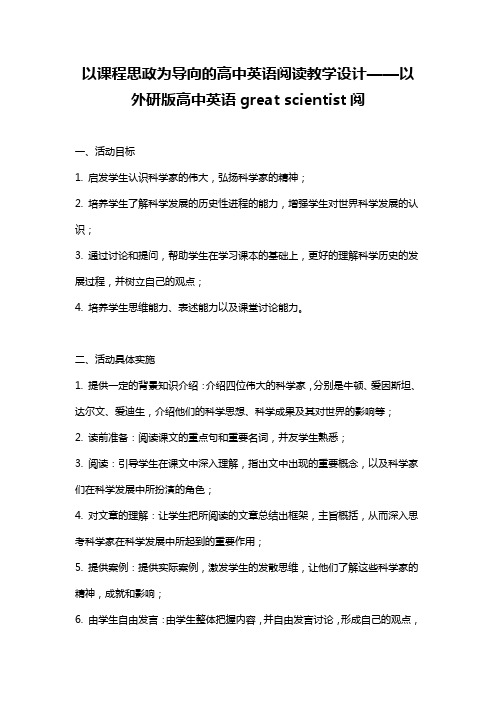
以课程思政为导向的高中英语阅读教学设计——以外研版高中英语great scientist阅
一、活动目标
1. 启发学生认识科学家的伟大,弘扬科学家的精神;
2. 培养学生了解科学发展的历史性进程的能力,增强学生对世界科学发展的认识;
3. 通过讨论和提问,帮助学生在学习课本的基础上,更好的理解科学历史的发展过程,并树立自己的观点;
4. 培养学生思维能力、表述能力以及课堂讨论能力。
二、活动具体实施
1. 提供一定的背景知识介绍:介绍四位伟大的科学家,分别是牛顿、爱因斯坦、达尔文、爱迪生,介绍他们的科学思想、科学成果及其对世界的影响等;
2. 读前准备:阅读课文的重点句和重要名词,并友学生熟悉;
3. 阅读:引导学生在课文中深入理解,指出文中出现的重要概念,以及科学家们在科学发展中所扮演的角色;
4. 对文章的理解:让学生把所阅读的文章总结出框架,主旨概括,从而深入思考科学家在科学发展中所起到的重要作用;
5. 提供案例:提供实际案例,激发学生的发散思维,让他们了解这些科学家的精神,成就和影响;
6. 由学生自由发言:由学生整体把握内容,并自由发言讨论,形成自己的观点,
促进学生思维修养,丰富他们的课堂文化氛围;
7. 后续工作:学生根据自己课文中所学和讨论的内容完成后续作业,检查学习效果。
三、板书设计
great scientists
Newton Einstein
Darwin Edison。
英语文章高中阅读听力教案
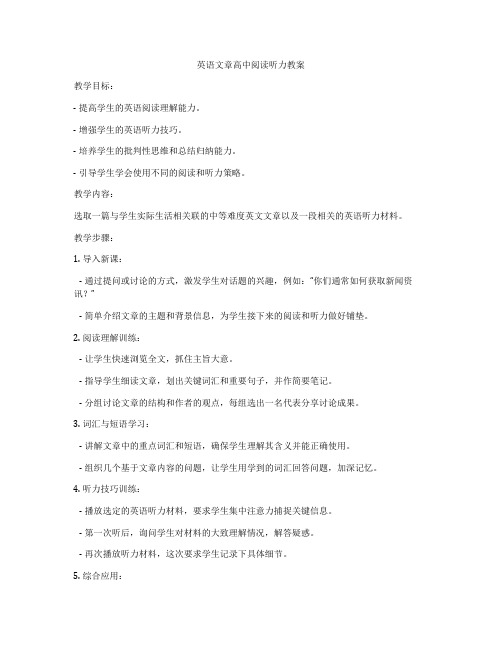
英语文章高中阅读听力教案教学目标:- 提高学生的英语阅读理解能力。
- 增强学生的英语听力技巧。
- 培养学生的批判性思维和总结归纳能力。
- 引导学生学会使用不同的阅读和听力策略。
教学内容:选取一篇与学生实际生活相关联的中等难度英文文章以及一段相关的英语听力材料。
教学步骤:1. 导入新课:- 通过提问或讨论的方式,激发学生对话题的兴趣,例如:“你们通常如何获取新闻资讯?”- 简单介绍文章的主题和背景信息,为学生接下来的阅读和听力做好铺垫。
2. 阅读理解训练:- 让学生快速浏览全文,抓住主旨大意。
- 指导学生细读文章,划出关键词汇和重要句子,并作简要笔记。
- 分组讨论文章的结构和作者的观点,每组选出一名代表分享讨论成果。
3. 词汇与短语学习:- 讲解文章中的重点词汇和短语,确保学生理解其含义并能正确使用。
- 组织几个基于文章内容的问题,让学生用学到的词汇回答问题,加深记忆。
4. 听力技巧训练:- 播放选定的英语听力材料,要求学生集中注意力捕捉关键信息。
- 第一次听后,询问学生对材料的大致理解情况,解答疑惑。
- 再次播放听力材料,这次要求学生记录下具体细节。
5. 综合应用:- 结合阅读和听力内容,设计一项任务,如写一篇简短的文章摘要或评论。
- 提供反馈,鼓励学生对自己的作品进行自我评价。
6. 总结回顾:- 总结本节课所学的阅读和听力策略。
- 强调在日常生活和学习中运用这些策略的重要性。
7. 作业布置:- 分配适当的阅读和听力练习作为家庭作业,以巩固课堂所学知识。
高中英语阅读教学设计活动
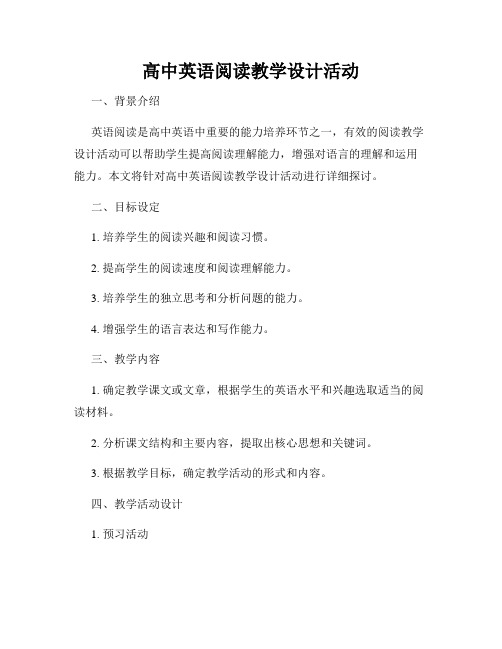
高中英语阅读教学设计活动一、背景介绍英语阅读是高中英语中重要的能力培养环节之一,有效的阅读教学设计活动可以帮助学生提高阅读理解能力,增强对语言的理解和运用能力。
本文将针对高中英语阅读教学设计活动进行详细探讨。
二、目标设定1. 培养学生的阅读兴趣和阅读习惯。
2. 提高学生的阅读速度和阅读理解能力。
3. 培养学生的独立思考和分析问题的能力。
4. 增强学生的语言表达和写作能力。
三、教学内容1. 确定教学课文或文章,根据学生的英语水平和兴趣选取适当的阅读材料。
2. 分析课文结构和主要内容,提取出核心思想和关键词。
3. 根据教学目标,确定教学活动的形式和内容。
四、教学活动设计1. 预习活动在课前引导学生预习课文,可以通过讲解课文背景、提出问题或进行小组讨论等形式,激发学生的学习兴趣,准备阅读材料。
2. 阅读活动(1)选择合适的阅读策略,例如快速阅读、细读、扫读等,根据课文或文章的内容和要求设计阅读任务。
(2)引导学生根据关键词和问题阅读课文或文章,培养学生捕捉信息和推理的能力。
(3)进行让学生互相讲述或作小组讨论等形式的互动活动,帮助学生加深理解和共享知识。
3. 听说活动(1)设计听力活动,例如听录音填空、听取细节、听后复述等,培养学生的听力技巧和理解能力。
(2)开展口语活动,例如小组讨论、辩论、角色扮演等,提高学生的口语表达能力。
4. 写作活动(1)根据课文或文章设计写作任务,例如写读后感、写观点陈述等,提高学生的写作能力。
(2)进行互评活动,学生可以互相交换作文并进行批改和评价,促进学生的写作水平的提高。
五、评价与反馈针对教学设计活动,及时进行评价和反馈是必要的。
可以通过小测验、作业批改、学生自评等形式进行评价,帮助学生改进和提高。
六、教学延伸为了进一步提高学生的阅读能力,可以引导学生进行额外的阅读活动,例如自主阅读、课外阅读、听读英语原著等,拓展学生的阅读广度和深度。
七、总结通过设计有效的高中英语阅读教学活动,可以提高学生的阅读水平和英语综合能力。
高中英语新人教必修一Unit 1 Teenage life period 2 阅读课教学设计教案3份

【新教材】必修第一册Unit 1 Teenage Life 教学设计(人教版)Period 2 Reading and Thinking本板块包括阅读部分The freshman Challenge 和在阅读基础上完成相关的词汇和问答练习。
Reading部分介绍的是高中新生Adam在新的学习环境中面临的挑战和机会。
本文内容贴近学生生活,主人公的问题和困惑也是学生们现在所面对的,通过回答和课文有关的问题和相关的拓展问题,学生可以以积极的心态迎接自己的高中生活。
为了顺利完成Reading and Thinking 的任务,学生还要提前做好相关词汇准备。
1. Let students master useful words and phrases related to the text;2. Let students understand the challenges Adam meets in his new school and compare the similarities and differences of their school and Adam’s;3. Help the students finish vocabulary exercises in the text book.4. Get students to understand they should learn to face difficulties and challenges in senior high school for their own future.Importance:1.Help the students to master key words and phrases in the text.2.Guide students to compare school life in different places.3. Guide the students to learn about Adam’s school life and understand that everyone should overcome difficulties in a new situation.Difficulty:Guide the students compare their sc hool life and Adam’s, and discuss ways to deal with challenges.1.Ask the students to prepare new words and phrases related to the contents of the text.2.Mark the new words in the textbook, understand the meaning in context, or consult the dictionary to understand the meaning.Step 1 Preparation1.freshman___________ junior high school ___________ Senior highschool___________confusing___________ choose courses___________ sign up___________extra-curricular activities___________hand out ___________ homeless people___________ in the community ___________ get used to doing___________ keep up with ___________2.challenge _________ topic________ fluent _________ graduate ________recommend ___________ literature_________ obviously _________quit_________be responsible for _________ schedule_________ editor_________Step 2 Warming upCompare school life in different placesActivity 11.Guide the students to take part in the group work and discuss school life in and out of China.Ask Ss to work in groups and discuss the questions.1)What do you want to know about the school life in other countries?Possible answers:I want to know whether they take extra courses during summer or winter vocations.I wonder if they have enough free time to develop their own interests.I am interested in what subjects they study at school.…2)What would you tell a teenager from another country about school life in China?I am happy to come to my new school and know a lot of new friends.Our teachers are patient and helpful.I feel a little worried about my study because I have more subjects to learn.…Activity 22.Read the text quickly to find the main idea of each paragraph.Guide the students to read the text quickly and fill in the blanks in this part.Possible answers:Paragraph1:Senior high school is a Challenge.Paragraph2:It is important to choose courses.Paragraph3:Extra-curricular activities are also important.Paragraph4:A senior high student must work harder and be more responsible.Step3 Intensive readingActivity 3Read the text again and answer the questions.Guide the students to read the text carefully and find the answers to the following questions.1.What causes did Adams choose? Which one do you think would be his favorite? Why?2.What does “make the team” in paragraph mean?3.What is Adam worried about?4.Is Adam confident that he will get used to senior school life? How do you know?Possible answers:1.Adam chooses Math, English chemistry, world history and Chinese. I think. English advancedliterature is his favorite because he likes English, and he is good at it.2.It means joining the football team.3.He is worried that he can’t keep up with other students in his advanced course and get used to allthe homework.4.Yes, he is. On the one hand, Adam knows that he has to study harder as a senior school studentto be well prepared for his future. On the other hand, Adam knows that school advisers andteacher can give him help when he is faced with problems.Activity 4Complete the outline. Then discuss the questions below with a partner.Get the students to work in pairs and fill in the blanks after discussing the questions carefully. Encourage the students to find clues from the text.Guide the students to discuss the following questions and encourage them to answer the questions according to Adam’s story and their own situation.1.What kind of person do you think Adam is? Why?2.Do you face the same challenges as Adams? What other challenges are you facing?3.What are some differences between Adam’s school and your school life?Possible answers:1.Adam is clear-minded and responsible for himself. When he chooses courses, he knows hisadvantages。
高中英语补充阅读教案
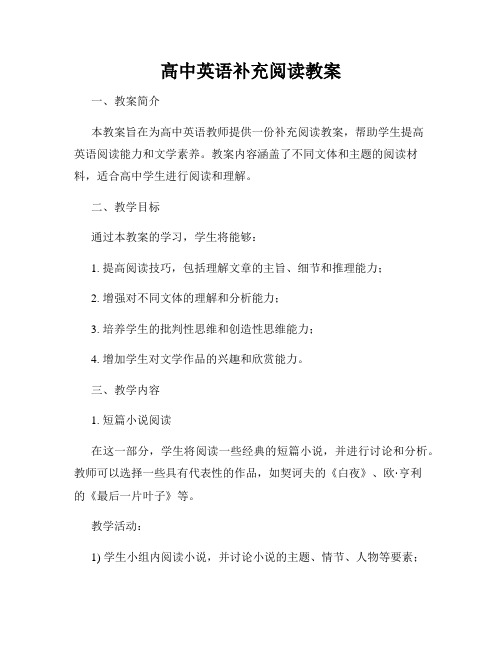
高中英语补充阅读教案一、教案简介本教案旨在为高中英语教师提供一份补充阅读教案,帮助学生提高英语阅读能力和文学素养。
教案内容涵盖了不同文体和主题的阅读材料,适合高中学生进行阅读和理解。
二、教学目标通过本教案的学习,学生将能够:1. 提高阅读技巧,包括理解文章的主旨、细节和推理能力;2. 增强对不同文体的理解和分析能力;3. 培养学生的批判性思维和创造性思维能力;4. 增加学生对文学作品的兴趣和欣赏能力。
三、教学内容1. 短篇小说阅读在这一部分,学生将阅读一些经典的短篇小说,并进行讨论和分析。
教师可以选择一些具有代表性的作品,如契诃夫的《白夜》、欧·亨利的《最后一片叶子》等。
教学活动:1) 学生小组内阅读小说,并讨论小说的主题、情节、人物等要素;2) 学生进行个人或小组演绎,以提高对故事的理解和表达能力;3) 教师引导学生分析文本的语言特点和故事结构。
2. 新闻报道阅读这部分通过阅读新闻报道,使学生了解并关注最新的社会热点和国际动态。
教师可以选择一些有趣且具有教育意义的新闻报道,如科技新闻、社会问题、环保等。
教学活动:1) 请学生在阅读前猜测新闻的主题和内容;2) 学生进行速读,了解大意,并回答相关问题;3) 学生与同伴讨论新闻报道的价值和影响。
3. 文化遗产介绍这部分通过介绍或阅读关于世界各地的文化遗产的文章,增强学生对不同文化的理解和欣赏。
教师可以选择一些世界著名的文化遗产,如埃及金字塔、中国长城等。
教学活动:1) 教师进行文化背景的介绍,并展示相关图片或视频;2) 学生进行阅读,并回答问题,例如这个文化遗产的历史、建筑风格、文化意义等;3) 学生分组进行展示,分享对文化遗产的理解和想法。
1. 创设情境为了激发学生的学习兴趣和积极性,教师可以创设相关的情境,如模拟新闻发布会、组织文学讨论会等,让学生在轻松的氛围中进行学习和交流。
2. 合作学习学生在小组内进行讨论和合作,可以提高学生的语言表达能力和批判性思维能力。
高中英语阅读专项导引教案

高中英语阅读专项导引教案
1. 教学目标
- 增强学生的英语词汇量和语法知识。
- 提升学生的快速阅读与精读技巧。
- 培养学生的批判性思维和分析能力。
- 引导学生学会总结和归纳文章主旨。
2. 教学内容
- 精选适合高中生阅读水平的英文文章,涵盖不同体裁和主题。
- 设计针对性的阅读问题,考察细节理解、推理判断及词义猜测等技能。
- 提供词汇和短语学习,帮助学生扩充语言资源。
3. 教学方法
- 采用任务驱动式教学法,通过具体任务激发学生学习兴趣。
- 实施分层教学,根据学生实际水平提供个性化指导。
- 结合多媒体工具,如视频、音频材料,增加课堂互动性。
4. 教学过程
- 导入:通过提问或讨论引出话题,激发学生兴趣。
- 新课呈现:教师引导学生阅读新材料,共同探讨文章结构和内容。
- 练习:学生独立或小组合作完成练习题,教师巡回指导。
- 总结:回顾本节课学到的知识点,强化记忆。
- 作业布置:根据课堂表现,分配适量的阅读和习题作业。
5. 评价方式
- 进行定期的阅读测试,检验学生的理解和分析能力。
- 通过课堂表现和作业完成情况,评估学生的学习进度。
- 鼓励学生自我评价,反思学习方法和效果。
6. 教学反思
- 教师需不断更新教学材料,确保内容的时效性和相关性。
- 关注学生的个体差异,调整教学策略以满足不同需求。
- 定期收集学生反馈,优化教学方法和过程。
7. 结语。
高中英语阅读欣赏课教学设计【案例】

【导语】教育要使⼈愉快,要让⼀切的教育带有乐趣。
⽆忧考⼩编准备了⾼中英语阅读欣赏课教学设计案例,希望对你有帮助!⼀、案例实施背景任何语⾔的习得和学习都离不开⼤量阅读的实践。
许多教师也意识到⾼中阅读对于学⽣综合语⾔能⼒培养的重要性,⽤尽各种办法来培养学⽣的阅读微技能。
当然这样做的⽬的确实也提⾼了学⽣测试性阅读的能⼒。
如阅读前讲解重点⽣词或词组,阅读中找main idea, 设计不同程度的问题帮助不同层次学⽣理解阅读,呈现表格,运⽤复述,⾓⾊扮演,采访等不同形式来开展阅读任务。
以上虽均衡了话题及功能两⽅⾯,但这些⽅法仍只停留在字,词,句及其他细节的表层理解上。
要想真正让学⽣内化阅读材料,除了表层的理解外,阅读也要关注语⾔⽂字背后的深层理解和⽂化内涵。
这点我们可以从语⽂学习上得到启⽰。
《英语新课程标准》就阅读的知识性和欣赏性上提出了指导思想:语⾔有丰富的⽂化内涵。
英语学习就是要关注说英语国家的历史地理、风⼟⼈情、传统习俗、⽣活⽅式、⽂学艺术、⾏为规范、价值观念等,从⽽加深对世界⽂化的理解。
因此,笔者认为⾼中英语阅读课除了训练测试性阅读之外,需要⼤量的欣赏性阅读材料来补充教学。
教师应该冲破词汇,语法的束缚,在阅读中突出技能渗透的同时,应将课⽂阅读教学提⾼到欣赏性阅读的美学⾼度,真正培养他们的英语学习兴趣。
⼆、教学内容分析教学内容为⾼⼀NSEFC Book 1 Unit 4的reading task。
作为地震内容的阅读补充材料,它是作家Jack London的笔下之作。
以⼀个⽬击者的⾝份,介绍了旧⾦⼭⼤地震的所见所闻所感。
语⾔地道优美,描述性较强。
重点是欣赏阅读中训练略读和查读两⼤阅读微技能,逐步加深对旧⾦⼭地震及细节理解,并对地震中发⽣的⼀切形成⾃⼰的观点看法和情感态度,体会⼈们地震后表现出来的勇敢精神。
本课难点是如何引导学⽣paraphrase 课⽂中的⼏个句⼦如A list of the brave men and women would filla library. A list of buildings undestroyed was now only a few addresses.三、学⽣分析教学对象为⾼⼀学⽣,他们的认知能⼒较初中学⽣有了⼀定的发展,有着更强的求知欲。
高中英语阅读教学之Pre-reading教学设计

高中英语阅读教学之Pre-reading教学设计Pre-reading教学设计在英语阅读教学中起着重要的作用。
通过预读,学生能够提前了解文章的背景信息和主题,增强对文章的了解和理解能力。
本文将讨论Pre-reading教学设计的重要性,并提供一些有效的教学策略。
一、引入话题在引入新的阅读材料之前,教师可以通过提问或讨论的方式引导学生思考话题并激发学生的兴趣。
例如,如果要教授一篇关于环境保护的文章,可以先问学生他们对环境保护有什么了解,并引导他们讨论环境保护的重要性。
二、创设情境在Pre-reading阶段,教师可以通过创设情境来引导学生进入文章的世界。
例如,可以通过图片、视频或故事等方式引导学生对文章的背景进行想象,从而提前建立起与文章相关的背景知识。
三、词汇预测通过词汇预测可以帮助学生猜测文章中的生词,并提前了解文章的关键词汇。
教师可以提供一些与文章相关的词汇,并引导学生根据词汇的音、形、义进行分析和推测。
这样可以帮助学生预先了解文章的一些关键词语,为阅读做好准备。
四、阅读目标设定在Pre-reading阶段,教师还可以设定阅读目标来引导学生阅读。
阅读目标可以是提问、回答问题或者总结文章的主要内容等。
通过设定阅读目标,学生可以在阅读过程中更有针对性地获取信息,提高阅读效果。
五、预测文章结构在开始阅读之前,教师可以引导学生通过浏览文章的标题、开头、结尾和关键句子等,来预测文章的结构。
这有助于学生在阅读时更好地理解文章的组织结构,提高阅读理解能力。
六、背景知识呈现通过呈现与文章相关的背景知识,可以帮助学生更好地理解和理解文章内容。
教师可以通过图片、图表、视频等多种媒体形式,引导学生了解文章所涉及的背景知识,为阅读做好铺垫。
七、预测文章内容在Pre-reading阶段,学生可以根据文章的标题、图表、插图等内容,推测文章的主题和内容。
教师可以通过提问或其他互动方式,引导学生预测文章的大意,从而激发学生的阅读兴趣。
高中英语选修三Unit 3 Environmental Protection阅读部分教学设计教案2份
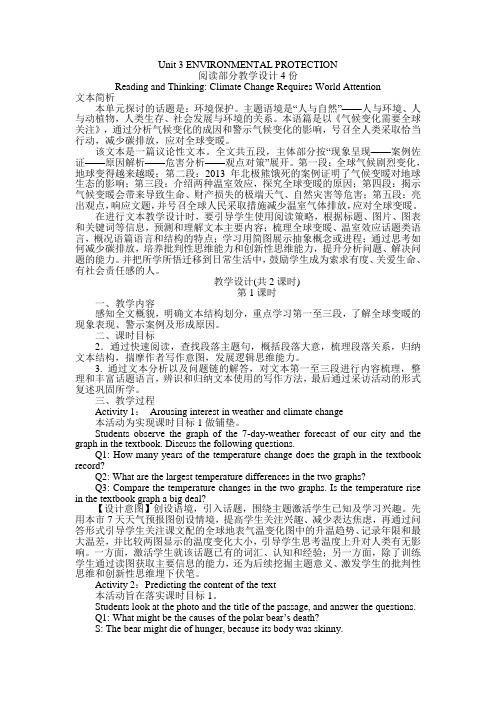
Unit 3 ENVIRONMENTAL PROTECTION阅读部分教学设计4份Reading and Thinking: Climate Change Requires World Attention文本简析本单元探讨的话题是:环境保护。
主题语境是“人与自然”——人与环境、人与动植物,人类生存、社会发展与环境的关系。
本语篇是以《气候变化需要全球关注》,通过分析气候变化的成因和警示气候变化的影响,号召全人类采取恰当行动,减少碳排放,应对全球变暖。
该文本是一篇议论性文本。
全文共五段,主体部分按“现象呈现——案例佐证——原因解析——危害分析——观点对策”展开。
第一段:全球气候剧烈变化,地球变得越来越暖;第二段:2013年北极熊饿死的案例证明了气候变暖对地球生态的影响;第三段:介绍两种温室效应,探究全球变暖的原因;第四段:揭示气候变暖会带来导致生命、财产损失的极端天气、自然灾害等危害;第五段:亮出观点,响应文题,并号召全球人民采取措施减少温室气体排放,应对全球变暖。
在进行文本教学设计时,要引导学生使用阅读策略,根据标题、图片、图表和关键词等信息,预测和理解文本主要内容;梳理全球变暖、温室效应话题类语言,概况语篇语言和结构的特点;学习用简图展示抽象概念或进程;通过思考如何减少碳排放,培养批判性思维能力和创新性思维能力,提升分析问题、解决问题的能力。
并把所学所悟迁移到日常生活中,鼓励学生成为索求有度、关爱生命、有社会责任感的人。
教学设计(共2课时)第1课时一、教学内容感知全文概貌,明确文本结构划分,重点学习第一至三段,了解全球变暖的现象表现、警示案例及形成原因。
二、课时目标2.通过快速阅读,查找段落主题句,概括段落大意,梳理段落关系,归纳文本结构,揣摩作者写作意图,发展逻辑思维能力。
3. 通过文本分析以及问题链的解答,对文本第一至三段进行内容梳理,整理和丰富话题语言,辨识和归纳文本使用的写作方法,最后通过采访活动的形式复述巩固所学。
高中英语优秀教学设计5篇
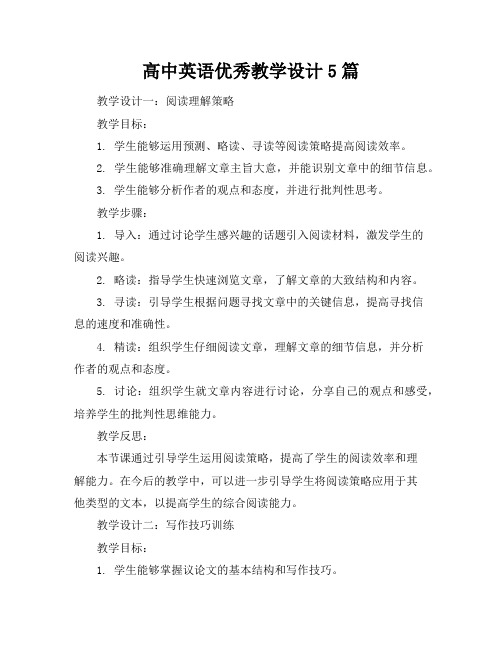
高中英语优秀教学设计5篇教学设计一:阅读理解策略教学目标:1. 学生能够运用预测、略读、寻读等阅读策略提高阅读效率。
2. 学生能够准确理解文章主旨大意,并能识别文章中的细节信息。
3. 学生能够分析作者的观点和态度,并进行批判性思考。
教学步骤:1. 导入:通过讨论学生感兴趣的话题引入阅读材料,激发学生的阅读兴趣。
2. 略读:指导学生快速浏览文章,了解文章的大致结构和内容。
3. 寻读:引导学生根据问题寻找文章中的关键信息,提高寻找信息的速度和准确性。
4. 精读:组织学生仔细阅读文章,理解文章的细节信息,并分析作者的观点和态度。
5. 讨论:组织学生就文章内容进行讨论,分享自己的观点和感受,培养学生的批判性思维能力。
教学反思:本节课通过引导学生运用阅读策略,提高了学生的阅读效率和理解能力。
在今后的教学中,可以进一步引导学生将阅读策略应用于其他类型的文本,以提高学生的综合阅读能力。
教学设计二:写作技巧训练教学目标:1. 学生能够掌握议论文的基本结构和写作技巧。
2. 学生能够运用论据和论点进行有效的论证。
3. 学生能够进行自我修改和同伴互评,提高写作水平。
教学步骤:1. 导入:通过分析优秀议论文,引导学生了解议论文的基本结构和写作技巧。
2. 写作指导:讲解议论文的写作步骤,包括确定论点、寻找论据、组织文章结构等。
3. 实践练习:组织学生进行写作练习,并鼓励学生运用所学技巧进行创作。
4. 同伴互评:引导学生进行同伴互评,互相提出修改建议,提高写作水平。
5. 自我修改:指导学生根据同伴互评和自我反思进行修改,完善文章。
6. 展示与分享:组织学生展示自己的作品,并分享写作心得和体会。
教学反思:本节课通过讲解写作技巧和实践练习,提高了学生的写作能力。
在今后的教学中,可以进一步引导学生关注写作过程中的细节问题,如语法、拼写、标点等,以提高学生的写作质量。
教学设计三:口语交际能力提升教学目标:1. 学生能够运用恰当的口语表达技巧进行日常交流。
高中英语教学案例范文三篇

高中英语教学案例范文三篇1.介绍俄罗斯遗失琥珀屋的轶事2.研究描述世界文化遗产的起源、发展和保护等方面的情况3.提高阅读技能,让学生自己归纳课文内容4.结合中外文化遗产一起讨论,引起共鸣5.研究如何谈论文化遗产,形成保护文物的意识。
四、教学过程1.引入:通过图片展示和视频介绍,让学生了解世界文化遗产的概念和意义,引起学生对文化遗产的兴趣。
2.阅读课文:让学生自己阅读课文,并在阅读过程中记录重要信息,例如人名、地名、时间、事件等。
3.归纳课文内容:让学生自己归纳课文内容,并进行讨论,帮助学生理解课文。
4.结合中外文化遗产讨论:让学生结合自己所了解的文化遗产,进行讨论,引起共鸣。
5.研究如何谈论文化遗产:让学生研究如何谈论文化遗产,例如如何描述文化遗产的起源、发展和保护等方面的情况。
6.总结:让学生总结本节课所学内容,并形成保护文物的意识。
五、教学反思本节课的教学效果还不错,学生对文化遗产的意义和重要性有了更深入的了解,也学会了如何谈论文化遗产。
但是,在教学过程中,我发现有些学生对课文内容的理解还不够深入,需要加强课后的巩固。
同时,我也需要更好地掌握学生的研究水平,让教学内容更加贴近学生的实际情况。
教学过程:一、引入教师通过图片和录音引入文化遗产的话题,展示琥珀屋的新旧图片,给学生感官上的刺激,帮助学生理解文章。
教师可以在板书上记录一些生词。
二、精读练学生阅读课文后进行精读练,回答问题掌握细节,了解琥珀屋从形式-失踪-重建的过程,从整体上把握它的结构、特色,并研究用英语归纳以及复述。
三、设计小对话两人围绕琥珀屋设计小对话,练口语表达能力,同时研究难句的解释。
四、小结文章学生找关键线索,分析文章的写作手法,小结上完这节课的收获,使他们的掌握阅读技巧的同时也增加了见识。
五、小组讨论学生进行小组讨论,复述课文,加深对文章的理解,并总结自己通过本课研究学到了什么,达到教学目标--形成保护文物意识。
六、教学策略教师采用多媒体教学,用一些有关文物的精美图片,引起学生对即将阅读的文章的兴趣,减少陌生感。
高中英语阅读新概念教案
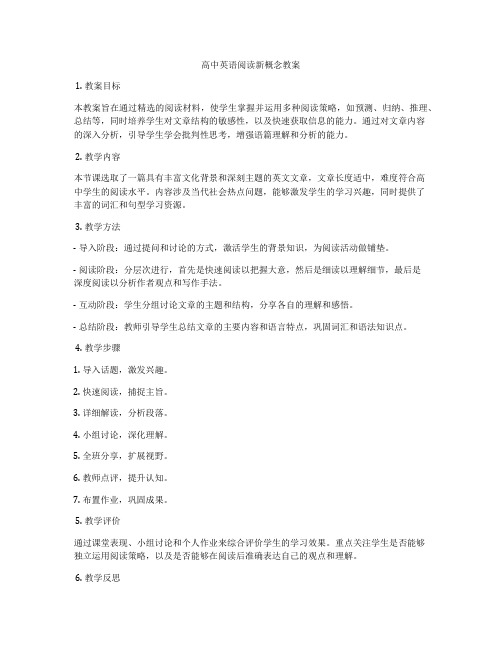
高中英语阅读新概念教案1. 教案目标本教案旨在通过精选的阅读材料,使学生掌握并运用多种阅读策略,如预测、归纳、推理、总结等,同时培养学生对文章结构的敏感性,以及快速获取信息的能力。
通过对文章内容的深入分析,引导学生学会批判性思考,增强语篇理解和分析的能力。
2. 教学内容本节课选取了一篇具有丰富文化背景和深刻主题的英文文章,文章长度适中,难度符合高中学生的阅读水平。
内容涉及当代社会热点问题,能够激发学生的学习兴趣,同时提供了丰富的词汇和句型学习资源。
3. 教学方法- 导入阶段:通过提问和讨论的方式,激活学生的背景知识,为阅读活动做铺垫。
- 阅读阶段:分层次进行,首先是快速阅读以把握大意,然后是细读以理解细节,最后是深度阅读以分析作者观点和写作手法。
- 互动阶段:学生分组讨论文章的主题和结构,分享各自的理解和感悟。
- 总结阶段:教师引导学生总结文章的主要内容和语言特点,巩固词汇和语法知识点。
4. 教学步骤1. 导入话题,激发兴趣。
2. 快速阅读,捕捉主旨。
3. 详细解读,分析段落。
4. 小组讨论,深化理解。
5. 全班分享,扩展视野。
6. 教师点评,提升认知。
7. 布置作业,巩固成果。
5. 教学评价通过课堂表现、小组讨论和个人作业来综合评价学生的学习效果。
重点关注学生是否能够独立运用阅读策略,以及是否能够在阅读后准确表达自己的观点和理解。
6. 教学反思课后,教师需根据学生的反馈和学习成果,对教案进行调整和优化。
这包括调整阅读材料的难度,改进教学方法,或是增加更多互动性和参与性的活动。
高中英语-Poems-阅读课教学设计学情分析教材分析课后反思全文编辑修改
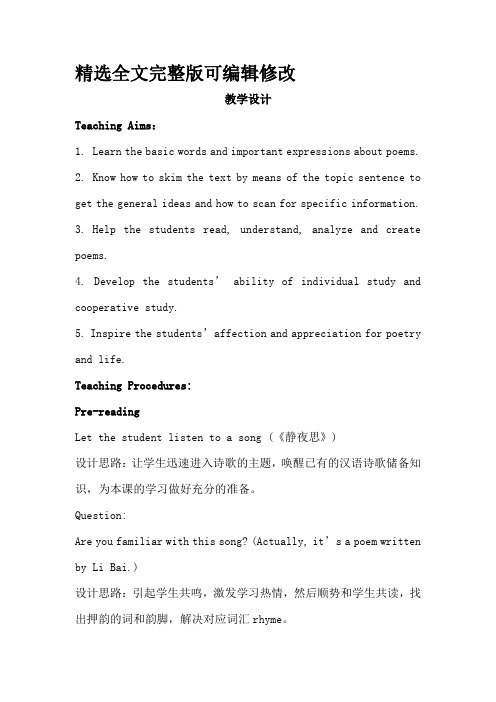
精选全文完整版可编辑修改教学设计Teaching Aims:1. Learn the basic words and important expressions about poems.2. Know how to skim the text by means of the topic sentence to get the general ideas and how to scan for specific information.3. Help the students read, understand, analyze and create poems.4. Develop the students’ability of individual study and cooperative study.5. Inspire the students’affection and appreciation for poetry and life.Teaching Procedures:Pre-readingLet the student listen to a song (《静夜思》)设计思路:让学生迅速进入诗歌的主题,唤醒已有的汉语诗歌储备知识,为本课的学习做好充分的准备。
Question:Are you familiar with this song? (Actually, it’s a poem written by Li Bai.)设计思路:引起学生共鸣,激发学习热情,然后顺势和学生共读,找出押韵的词和韵脚,解决对应词汇rhyme。
Look at the English translation of the poem and find the rhymes Question: Why did Li Bai write this poem?设计思路:引导学生思考诗歌的作用和意义,对应课文第一段内容。
高中英语阅读课教学案例
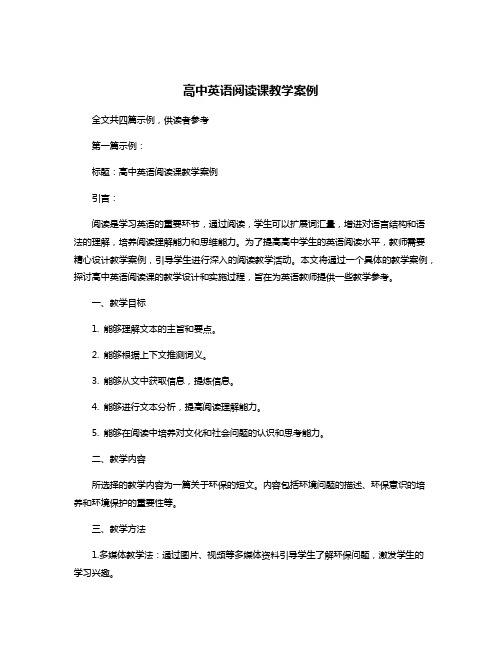
高中英语阅读课教学案例全文共四篇示例,供读者参考第一篇示例:标题:高中英语阅读课教学案例引言:阅读是学习英语的重要环节,通过阅读,学生可以扩展词汇量,增进对语言结构和语法的理解,培养阅读理解能力和思维能力。
为了提高高中学生的英语阅读水平,教师需要精心设计教学案例,引导学生进行深入的阅读教学活动。
本文将通过一个具体的教学案例,探讨高中英语阅读课的教学设计和实施过程,旨在为英语教师提供一些教学参考。
一、教学目标1. 能够理解文本的主旨和要点。
2. 能够根据上下文推测词义。
3. 能够从文中获取信息,提炼信息。
4. 能够进行文本分析,提高阅读理解能力。
5. 能够在阅读中培养对文化和社会问题的认识和思考能力。
二、教学内容所选择的教学内容为一篇关于环保的短文。
内容包括环境问题的描述、环保意识的培养和环境保护的重要性等。
三、教学方法1.多媒体教学法:通过图片、视频等多媒体资料引导学生了解环保问题,激发学生的学习兴趣。
2.启发式教学法:通过提出问题、展示情景等方式引导学生主动思考、发现问题、寻找解决问题的方法。
3.合作学习法:设计小组讨论、合作阅读等活动,让学生在合作中相互学习、思考,激发学生的学习热情。
四、教学过程1.课前导入2.课堂授课以小组活动的形式展示短文内容,让学生对环保问题有一个整体的认识。
然后,教师可以选择一些重点段落进行讲解,重点讲解一些语言点,并进行相关词汇的讲解和拓展。
3.合作学习通过小组讨论、合作阅读等活动,让学生在合作中相互学习、思考,提高阅读理解能力。
学生可以在小组中相互交流想法,共同解决阅读中遇到的问题,增强对环保问题的理解和认识。
4.课堂总结教师对本节课的内容进行总结,鼓励学生对所学知识进行总结和提炼。
可以通过提问、讨论等方式激发学生对环保问题的思考和探索。
五、教学评价教学过程中,教师可以通过观察学生的表现和小组讨论的情况等来对学生的阅读理解能力和综合能力进行评价。
可以设计一些阅读理解题目、课堂问题等进行及时的检测。
高中英语教案(优秀8篇)

高中英语教案(优秀8篇)高中英语教学设计篇一单元整体设计思路第一课时:阅读课Warming up; Pre-reading; Reading; Comprehending (pp. 1-2)第二课时:语法课Discovering useful structures (p. 4); Using structures (p. 43)第三课时:阅读与听说课Reading and listening; Speaking (pp. 5-6)第四课时:词汇课Discovering useful words and expressions (p. 3); Using words and expressions (p. 42)第五课时:听说课Listening; Talking (p. 41)第六课时:读写课Reading and writing (p. 7)第七课时:单元评价课Self-test and self-evaluation; Summary第一课时阅读课一、教学内容Warming up; Pre-reading; Reading; Comprehending (pp. 1-2)二、教学目标在本节课结束时,学生能够了解文化遗产的基本概念、本质特点以及基本类型。
通过找读(scanning)关键词、略读(skimming) 和精读(careful reading),了解有关琥珀屋的故事。
用归类法学习词汇。
用自己的话复述琥珀屋的故事。
运用本课时学习的内容和自己已有的知识讨论相关话题。
三、教学步骤步骤一热身1.请学生看学生用书p. 1或者PPT中的图片,两人一组讨论三个问题。
教师请几组学生回答问题,然后综合大家的看法总结出文化遗产的定义。
2. 请学生说出一些中外文化遗产的名称,教师写在黑板上。
可以采取小组竞赛的形式,比一比看哪组说得多、说得正确。
注:问题中出现了五个生词。
rare, valuable和survive很难根据上下文猜出词义,教师可以布置学生课前查字典自学其词义,用法可以留到词汇课处理。
高中英语阅读课教学设计新案例 5

高中英语阅读课教学设计新案例 5高中英语阅读课教学设计新案例5高中英语阅读课教学设计案例高中英语(sefc)阅读课文具有题材广泛、体裁各样、语言知识丰富等特征,是各单元教学的核心部分,也是培养学生阅读能力的主要渠道。
然而,传统的阅读课教学模式常常是单一的自下而上模式,教学方式只是把课文作为单纯向学生传授语法及语言知识的载体,忽视了培养学生的阅读速度和理解能力;传统的阅读理解提问方式也常常停留在对所阅读文章的表层理解层次上。
那么,如何借助这些课文来提高学生的阅读速度、阅读理解能力和语言水平呢?经过教学实践和不断尝试,笔者发现:不同阅读活动阶段,必须采用不同阅读理解模式以求不同阅读教学目标的实现。
下面以sefcbook1aunit7\单元阅读课为例对这一问题进行探析。
一、firstcreading采用自上而下模式,侧重培养快速阅读理解能力“自上而下模式”是古德曼1971年提出的阅读理论模式。
该理论反对将阅读视为对一系列单词和句子的感知,并认为读者不必在所有文本中使用暗示。
他们在文章中选择足够的信息进行预测,并用自己对客观世界的经验和知识来验证自己的预测。
根据这个模型,读者在阅读过程中并不是逐字逐句地理解,而是结合自己的预测来找出文章中的相关信息来验证自己的预测。
这种模式有优点也有缺点。
缺点是不利于学生对基本语言知识的掌握,容易导致学生的基本语言技能不扎实。
然而,由于强调整体文本理解,以及阅读中跳跃式搜索和猜测的方法,这有利于培养学生的快速阅读理解能力。
阅读速度的培养是阅读教学中一个重要的任务。
目前,中学生阅读能力在速度上与可能达到的指标相比普遍要低几倍,甚至十几倍。
随着信息时代的到来,人们急需尽快获取各种信息资料,成倍提高工作效率与学习效果,培养学生的快速阅读理解能力是实施英语素质教育的必然要求。
然而,训练学生阅读速度必须建立在学生对文章内容处于陌生状态的基础上,因此,在学生初次接触阅读课文时,应该采用自上而下阅读模式,不失时机地培养他们的快速阅读习惯、快速阅读理解能力。
高中英语阅读教学设计例说
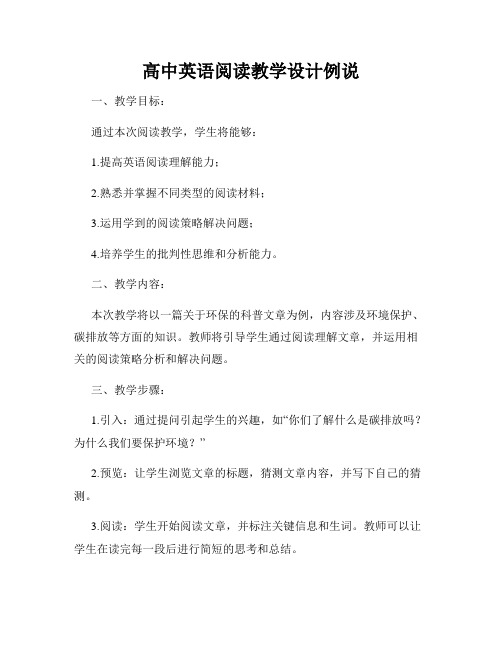
高中英语阅读教学设计例说一、教学目标:通过本次阅读教学,学生将能够:1.提高英语阅读理解能力;2.熟悉并掌握不同类型的阅读材料;3.运用学到的阅读策略解决问题;4.培养学生的批判性思维和分析能力。
二、教学内容:本次教学将以一篇关于环保的科普文章为例,内容涉及环境保护、碳排放等方面的知识。
教师将引导学生通过阅读理解文章,并运用相关的阅读策略分析和解决问题。
三、教学步骤:1.引入:通过提问引起学生的兴趣,如“你们了解什么是碳排放吗?为什么我们要保护环境?”2.预览:让学生浏览文章的标题,猜测文章内容,并写下自己的猜测。
3.阅读:学生开始阅读文章,并标注关键信息和生词。
教师可以让学生在读完每一段后进行简短的思考和总结。
4.词汇扩展:教师提供一些相关的词汇并与学生一起讨论其具体含义和在文章中的作用。
5.理解问题:教师提出一些与文章相关的问题,引导学生进行分析和思考。
例如,“为什么碳排放对环境有害?我们可以通过哪些方式减少碳排放?”6.小组合作:学生分成小组,共同讨论问题并提出解决方案。
每个小组汇报自己的观点和答案。
7.全班讨论:整合各组的观点,展开全班讨论。
教师引导学生分析不同方案的优缺点,并讨论最有效的解决方案。
8.总结:学生总结本次阅读的收获和体会,并写下一些新的问题或不确定的观点,以便下次进一步探讨。
四、教学评估:教师可以通过以下方式对学生的阅读理解和分析能力进行评估:1.观察学生在阅读过程中的主动性和积极性;2.提问学生关于文章内容和问题的观点;3.评价学生在小组合作和全班讨论中的表现;4.布置相关任务,如写一篇关于环保的短文,检验学生对该主题的理解和应用能力。
五、教学延伸:在教学过程中,教师可以引导学生进行更深入的研究和讨论,如展开话题延伸,扩展相关知识,或通过参观实地环保项目等方式提升学生的学习兴趣和参与度。
- 1、下载文档前请自行甄别文档内容的完整性,平台不提供额外的编辑、内容补充、找答案等附加服务。
- 2、"仅部分预览"的文档,不可在线预览部分如存在完整性等问题,可反馈申请退款(可完整预览的文档不适用该条件!)。
- 3、如文档侵犯您的权益,请联系客服反馈,我们会尽快为您处理(人工客服工作时间:9:00-18:30)。
设计教师:深圳市龙华中学张兆玉教学年级:高二课题名称:Unit3 Inventors and Inventions—The problem of the snakes 教材版本:NSEFC BOOK8授课时间:40分钟(Ⅰ)Syllabuses ObjectivesIt is required in the New Syllabuses that senior students should develop reading skills to read for information, to read for language knowledge and to read for pleasure. Senior Two students are supposed to achieve 8-graded objectives in the aspect of reading skills proposed in the New Syllabuses.(Ⅱ)Target materialWith the development of science and technology today, a variety of inventions and creations have come out from every aspect of our life. The thinking qualities and patterns of a person play an important role in his or her lifelong development. That’s why modern education needs to develop the learner’s creative thinking.The unit theme is about “Inventors and Inventions”, which covers “the difference between ‘Invention’ and ‘Discovery’”, “the stages in producing an invention” and “the patent application criteria.The 3A (“Awareness-Autonomy-Authenticity) teaching principle is embodied in the teaching design. The teacher is to help the students express their own ideas and opinions about a creative smart thing, and describe an invention.(Ⅲ) Academic levelSenior Two students, active in thinking and curious about everything, have already got lot of knowledge in science and technology from their science subjects. They are very familiar with the topic. They have the ability to communicate with each other about the target material, but they still have some difficulty expressing their own thoughts and describing an invention. Therefore, I can stimulate the Ss’ interest in this topic, and they will be motivated to accept the challenge to learn and use language to achieve these goals.The core task in this lesson is to read the passage “The Problem of the Snakes”. I ask the students to collect from the Internet some information about “inventions” before this lesson as a pre-lesson activity.(Ⅳ)Teaching objectivesLanguage-knowledge:1) To grasp the general idea and specific details of this text.2) To familiarize the Ss with the use of the past participle3) New words and expressions in the text.Language skills:Reading skills including the following and also follow on activities for speaking and writing about an invention.1)To develop the ability of reading for specific details.2)To grasp the logic links between paragraphs of the text.3)To learn to guess meanings in context.Learning Strategies:Cooperative learning by means of pair or group work.Affective objectives:Students are challenged to think creatively,to identify the difference between discovery and invention, and to experience the enjoyment in making an invention.Cultural awareness:To challenge the students to solve a real-life problem and share experiences with others in the process.To learn to be imaginative and creative.(Ⅴ)Teaching Strategies:Teaching approaches:1)The Communicative Approach: This lesson contains activitieswhere learners communicate and where tasks are completed by meansof interaction with other learners. There is extensive use of pair,group and mingling activities, with the emphasis on completing thetask successfully through communication with others.2)The Task- based Approach: I offer the student opportunities todo something—to acquire information and knowledge, to processinformation and to apply knowledge to solve an authentic problem.In this lesson I create a need to learn and use language. Studentsare assigned several tasks to complete in order to achieve aspecific outcome.Learning Strategies:Language is acquired as learners actively engaged in attempting to communicate in the target language. All the activities I designed are intended to provide various personalities opportunities to do things actively and to motivate students to fulfill their potential to achieve the goals by using English in a communicative classroom.That’s what the Learning-by-doing principle requires.Teaching Aids:Stud ents’ worksheet, a projector and a multimedia computer(Ⅶ)Post-lesson ReflectionIn principle, I adapt communicative and task- based approaches in this lesson. All the activities that focus on one main target are organized in a task-cycle with an outcome--- following the stages mentioned in the text to solve a real-world problem. The task cycle consists of a seriesof minor tasks, each of which serves one primary focus on enabling the learner to reach higher and higher levels of communicative performance. Consequently, students from different English levels can participate in the classroom activities all the way, and so they are challenged to achieve the main goal I set for them by means of different leaning strategies. That’s just what we teachers should take into consideration when we design our classroom teaching.1)The tasks set in a meaningful communicative classroom enable thestudents to process language which is being learned or recycled more naturally.2)The computer-assisted teaching aids contribute to improving theefficiency this lesson, by increasing the input of information.3)The post-reading task provides the students an opportunity to solvea problem in an authentic situation and use what they have learned todo something by communicating with others4)All the activities, arranged in the pattern: inputting information—processing information—outputting information, are meant tostrengthen the integrated skills.附学生课堂活动工作单:(Students’ worksheet):Task oneA discovery is____________________________________________________________________ .An invention is___________________________________________________________________. Task Two1________________________ 2_________________________3________________________ 4_________________________5_________________________ 6_________________________Task ThreeⅠ)Reading for general meaningParagraph1Paragraph 2 _________________________Paragraph 3 ____________Paragraph 4,5,6 _________________________Paragraph 7_____________________________Ⅱ)Reading for specific informationRead the passage carefully and choose the best answer:1) What’s the problem that the writer came across?A. Snakes come near her house now and then.B. Snakes seem to have made their home near her house.C. How to catch the snakes without harming them.D. Her mother felt upset.2)Why do you think the writer felt she had a chance to distinguishherself by inventing something to catch the snakes but not harm them?A. Because she is self-confident.B. Because she felt she would be able to find a creative solution tothe problem for her mother.C. Because her mother would praise her if she solved the problemsuccessfully.D. Because she would become an inventor if she solve the problem. 3) Why did the writer not use powders to solve the problem?A. Because it was an old thought pattern to used powders.B.Because that would harm or even kill the snakes.C.Because that would damage something else near the house.D.Because she wanted to invent something new.4)Which are the three possible approaches that the writer thoughtof to catch the snakes except_____.A. Removing their habitat.B. Attracting them into a trap using male or female perfume or foodC. Using the natural enemy of snakesD. Cooling the snakes5)Why did cooling the snakes make them less active?A. Because they are small reptilesB. Because they are cold-blooded and become sleepy when it is coldC. Because their body temperature changes with the heat around themD. Both B and C.6)In which order did the writer carry out the process of coolingthe snakes?a. took the bowl from the ice-cream maker.b. Placed the frozen bowl over the snakes’ habitat.c. Prepared some ice-cubes to keep the bowl cool.d. Covered the bowl with a bucket and left everything overnighte.. Frozen the bowl.A. a-e-c-b-dB. a-e-b-c-dC. e-c-b-d-aD. e-a-c-d-b7)How many attempts did she make to in order to make her solutionefficient?A. 2B. 3C. 4D. 58)Why do you think she failed for the first time?A. Because it was in the morning that it was not cool enough to make the snake well asleep.B.Because the snakes woke up in the morning.C.Because there was a hole in the wall.D.Because the snakes were crawling too fast for me to catch.9)What two factors (因素) that helped the writer solve the problemsuccessfully?A. her creativity and intelligence.B.her knowledge about reptiles and efforts to improve the solution.C.the ice-cream maker and the small fishing net.D.her carefulness and the desire to distinguish herself.10)Getting a patent for your invention has the following advantagesexcept that_____.A. You are able to prove that you are the first to make the invention and protect your invention.B.You are recognized as a real inventor.C.You are able to get a qualification as a patent officer.D.You can make money if you sell your inventions to others.11)According to the last paragraph, which of the following inventionscan get a patent?A. A computer program and a new plant varietyB. A game your teacher designed in your PE lessonC. A smart way you find to work out a certain math problemD. A environmentally friendly bus you designed12)According to the last paragraph, the criteria for a patent includethe following items except______.A. Your product needs to be smart something that helps to makepeople’s life easier and better.B.The product you make needs to be really different from everybodyelse’s.C.Your invention proves to be a copy from ot her’s productD.Your product has nothing in common with something else that alreadyexists in the world.Ⅲ)Read for language knowledge1 Read the passage carefully and guess the meaning of some new words andexpressions using the context clues. Then do the multiple choice below.13) The word “approach” in the second paragraph can be replacedby____________.A. arrivalB. methodC. movementD. request14) The habitat to an animal or plant is what the ________ to us humans.A. homeB. houseC. villageD. farm15) The word “abruptly” in the sentence “They abruptly disappearedinto a convenient hole in the wall.” means ________.A. fastB. quicklyC. suddenly and unexpectedlyD.completely15) The word “overnight” in the fifth paragraph means the same asit is in the followingsentences _______.A. Jackson became famous overnight.B.She left her pet dog outside overnight.C.The Pop group succeeded overnight.D.The show was an overnight success in Hollywood.16) The sentence in the sixth paragraph “This was in the expectationthat the snakes would bite again.” means the same as the following except________.A. I expected the snakes would bite me again.B.The snakes expected to bite me againC.It was expected that the snakes would bite me again.D.The snakes expected to bite me again17) The word “released”in the last sentence of the sixth paragraph means the same as _______.A. returnedB. relaxedC. dismissedD. set free18) The underlined word in the sentence “Pressed by my friends and relations, I decided to send my invention to the patent office….”can be best replaced by _________.A. pushedB. persuadedC. recommendedD. required19) Which of the following can take the place of the underlined word in the sentence, “I collected the passive snakes and the next day released them all back into the wild.A. inactiveB. positiveC. negativeD. sensitive20) What do you think the word “novel” in the sente nce “…unless they are truly novel” means?A. strangeB. uniqueC. new and unusualD. special。
